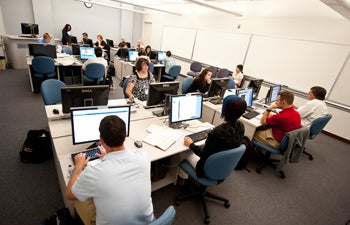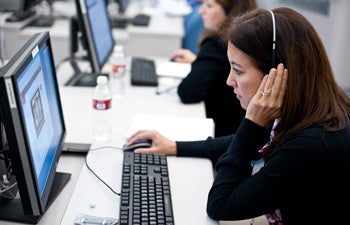Teaching with Testimony
The USC Shoah Foundation Institute for Visual History and Education recently hosted its third annual Teaching with Testimony workshop for nationwide educators to learn how to best implement the institute’s archive into classroom projects.
The July 18-22 workshop brought together 17 teachers from seven states to explore the ways in which they can help students examine prejudice, intolerance and bigotry in their daily lives. The workshop is aligned with institute’s focus to make educational and scholarly use of its archive of nearly 52,000 video testimonies of survivors and other witnesses of the Holocaust. Representing 56 countries in 32 languages, the archive is the largest of its kind in the world.
“By the end of the week each participant learned how to craft a testimony-based classroom resource,” said Sherry Bard, project director of educational programs in the institute, housed in USC Dornsife. “But they also came to understand the core concepts related to the educational use of testimony and its intersection with new media, as well as its potential applications across the curriculum.”

Teaching with Testimony workshop participants search for and watch testimony from the USC Shoah Foundation Institute’s Visual History Archive. Photo by Kim Fox Photography.
Bard hopes the workshop has a ripple effect.
“Participants will be able to share these concepts with other teachers, administrators and community leaders.”
The all-expenses paid workshop held on the University Park campus was made possible through a grant from the Leichtag Family Foundation. Based in Carlsbad, Calif., the foundation’s aim is to help buildself-sufficiency by giving people the tools they need to break the cycle of poverty. The foundation believes in giving voice to the vulnerable.
This year’s workshop comprised experienced educators who teach subjects in public and private middle schools, high schools and community colleges.
Participants were among the first educators trained to use IWitness, a groundbreaking resource for teachers and students that will make 1,000 English-language testimonies available on the Internet. The program is currently in the testing stage.
The institute’s staff gave an overview of the methodology for designing testimony-based projects, and trained educators how to best utilize its archive search engine, which allows users to search for and view testimony segments relating to specific topics such as “food in concentration camps” or “liberation day.”

Debra Lunamand, of Spring Valley Middle School in Spring Valley, Calif., listens to a survivor’s testimony during the third annual Teaching with Testimony workshop. The week-long workshop is held under the auspices of the USC Shoah Foundation Institute for Visual History and Education. Photo by Kim Fox Photography.
One workshop session included meeting with Renée Firestone, a Holocaust survivor and educator, and Edith Umugiraneza, one of the first survivors of the Rwandan Tutsi genocide who provided testimony to the institute. Faculty with the USC School of Cinematic Arts and the USC Institute for Multimedia Literacy held a discussion on ethical editing. Graduates from last year’s workshop shared how they developed classroom projects using testimony.
“The testimonies contain important lessons for humanity and they can be used within an academic framework,” said Stephen D. Smith, executive director of the institute. “The opportunity for educators and students is profound.”
Learn more about the workshop and institute’s Master Teacher Program at dornsife.usc.edu/vhi/education/mtw/